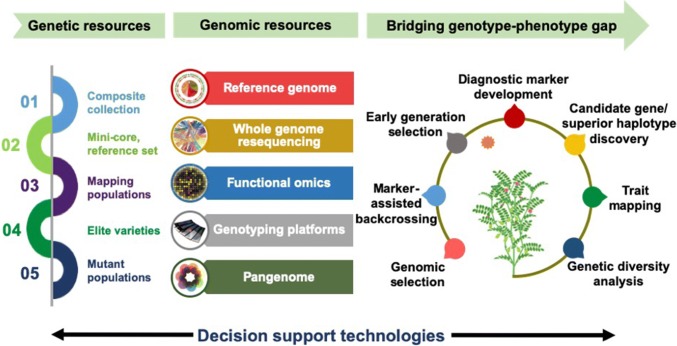Fig. 1.
Applications of genomic technologies for bridging the genotype–phenotype gap in chickpea. An overview of genetic resources together with genomic resources and technologies for bridging the genome-to-phenome gap to produce climate-resilient chickpea varieties. Sequencing/genotyping of chickpea germplasm resources, such as composite collection, mini-core and reference set, can be performed. Similarly, elite varieties, mapping populations including bi-parental (recombinant inbred lines, RILs; introgression lines, ILs; F2), multi-parental (multi-parent advanced generation intercrossing, MAGIC; nested association mapping, NAM) populations segregating for important agronomic traits, and mutant populations can also be used. With the availability of the reference genome, these genetic resources can be subjected to whole-genome re-sequencing (WGRS) or high- to low-density genotyping, based on the objective of the study, using the available genotyping platforms (e.g. genotyping by sequencing, GBS; array-based genotyping). Analysis at the transcriptome, proteome and metabolome levels can be performed to gain novel insights into the candidate genes and biological processes involved. A pangenome can be constructed to capture the entire set of genes from Cicer species. Analysis of this sequencing/genotyping data along with phenotyping data with high-throughput decision support technologies can provide solutions for genetic diversity analysis, genetic mapping and QTL analysis, identify candidate genes and superior haplotypes, and develop diagnostic marker, early generation selection, marker-assisted backcrossing (MABC) and genomic selection (GS). Integration of such resources should bridge the genotype–phenotype gap and accelerate the development of climate change ready varieties with higher yields, improved resistance against biotic and abiotic stresses and enhanced genetic gains in farmers’ fields, particularly in the dryland tropics.

